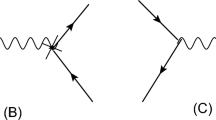Abstract
In this paper we address the question: do the limits on technirho production at the Tevatron mean what we think they do? These limits are based on calculations that rely on vector meson dominance (VMD). VMD was invented in order to describe the interaction of electrons with hadrons (the rho meson and pions). The method has been used also as a tool in the study of technicolor phenomenology. Nevertheless there is evidence in the sense that, even in its original context, VMD is not completely realized. In this work we investigate the consequences of a deviation from complete VMD for the phenomenology of colored technihadrons. We focus specially on the production of the color octet technirho and color triplet technipions. We found that a relatively small direct coupling of the proto-technirho to quarks is enough to suppress or even eliminate the interaction among quarks and the physical technirho. On the other hand, it is possible to suppress the coupling of the physical technirho to technipions, but in this case a large interaction among the technipions and the proto-gluon must be introduced. The consequences for the limits on the mass of the color octet technirho and colored triplets technipions are also investigated.
Similar content being viewed by others
References
C.T. Hill, E.H. Simmons, Phys. Rep. 381, 235 (2003) [arXiv:hep-ph/0203079]
C.T. Hill, Phys. Rep. 390, 553 (2004) [Erratum]
H.B. O’Connell, B.C. Pearce, A.W. Thomas, A.G. Williams, Prog. Part. Nucl. Phys. 39, 201 (1997) [arXiv:hep-ph/9501251]
D. Dominici, Riv. Nuovo Cimento 20, 1 (1997) [arXiv:hep-ph/9711385]
J. Schechter, Phys. Rev. D 34, 868 (1986)
A.R. Zerwekh, arXiv:hep-ph/0603096
K.D. Lane, M.V. Ramana, Phys. Rev. D 44, 2678 (1991)
E. Eichten, K.D. Lane, Phys. Lett. B 327, 129 (1994) [arXiv:hep-ph/9401236]
A.R. Zerwekh, R. Rosenfeld, Phys. Lett. B 503, 325 (2001) [arXiv:hep-ph/0103159]
R. Sekhar Chivukula, A. Grant, E.H. Simmons, Phys. Lett. B 521, 239 (2001) [arXiv:hep-ph/0109029]
A.R. Zerwekh, Int. J. Mod. Phys. A 19, 4387 (2004)
A.V. Semenov, arXiv:hep-ph/0208011
A. Semenov, LanHEP – a package for automatic generation of Feynman rules. User’s manual. INP MSU Preprint 96-24/431, Moscow, 1996, hep-ph/9608488
A.V. Semenov, A. Semenov, Nucl. Instrum. Methods A 393, 293 (1997)
A. Semenov, LanHEP – a package for automatic generation of Feynman rules from the Lagrangian. Updated version 1.3. INP MSU Preprint 98-2/503, http://theory.sinp.msu.ru/semenov/lanhep.html
A. Pukhov, arXiv:hep-ph/0412191
CDF Collaboration, F. Abe et al., Phys. Rev. D 55, 5263 (1997) [arXiv:hep-ex/9702004]
J. Pumplin, D.R. Stump, J. Huston, H.L. Lai, P. Nadolsky, W.K. Tung, JHEP 0207, 012 (2002) [arXiv:hep-ph/0201195]
R. Casalbuoni, P. Chiappetta, D. Dominici, A. Fiandrino, R. Gatto, Z. Phys. C 69, 519 (1996) [arXiv:hep-ph/9505212]
CDF Collaboration, T. Affolder et al., Phys. Rev. Lett. 85, 2056 (2000) [arXiv:hep-ex/0004003]
Author information
Authors and Affiliations
Corresponding author
Additional information
PACS
12.40.Vv; 12.60.Nz
Rights and permissions
About this article
Cite this article
Zerwekh, A. Consequences of partial vector meson dominance for the phenomenology of colored technihadrons. Eur. Phys. J. C 49, 1077–1081 (2007). https://doi.org/10.1140/epjc/s10052-006-0184-4
Received:
Revised:
Published:
Issue Date:
DOI: https://doi.org/10.1140/epjc/s10052-006-0184-4




